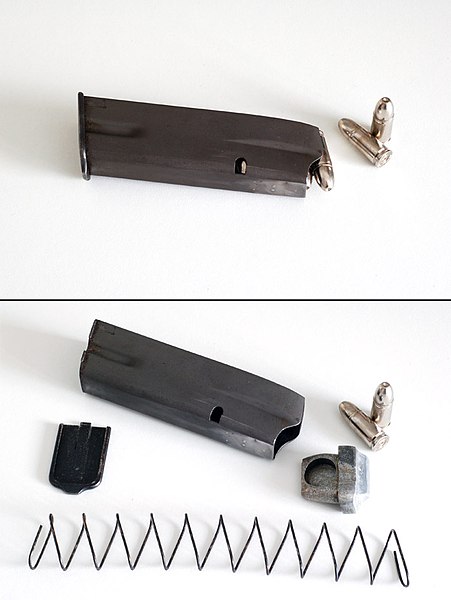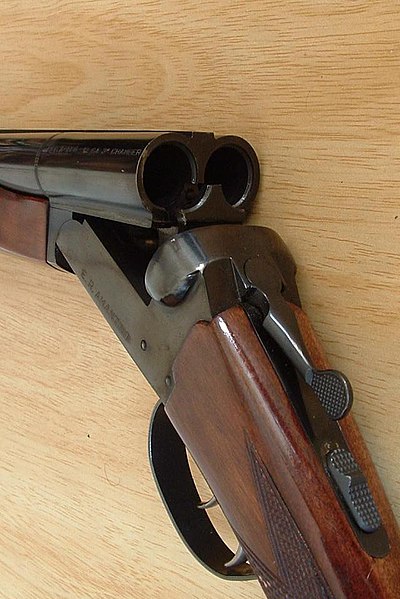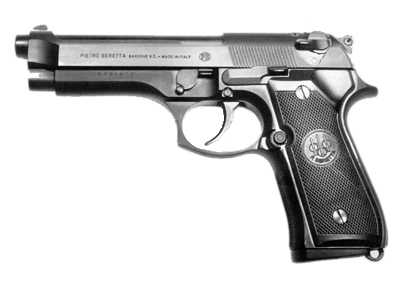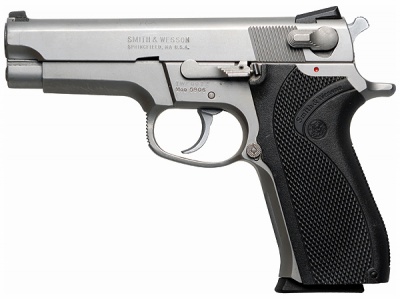Part I, Part II, Part III
How They Work
At their heart, guns are very simple devices. They are basically tubes with an explosive charge at the base. The tube must be strong enough to withstand the pressures of the explosion and force the projectile out of the open end of the gun.Barrel
What are the basic pieces that make up a firearm? They haven't changed since guns were first constructed. You need a breech, a Barrel, and some sort of trigger.The barrel is what the projectile moves down. Why is it called a barrel? Back in the good old days people did not have the knowledge or teleology to cast metal in to a solid cylinder. They did know how to make many small curved staves of metal. So they would create these staves of metal, and put them all together with iron hoops, just like they did to make wooden barrels. Thus, the name. The ends of the barrel have special names. The front is called the muzzle, and the rear, the breech.
The inside of the barrel is called the bore. The bore is very important to the flight of the projectile. There are two types of bores that are used. The smooth bore, and the rifled bore. The smooth bore is just that. The bore is smooth all the way down to the breech. There is nothing in the bore to affect the flight of the bullet.
The rifled bore has spiral groves cut in to the bore to spin the bullet as it leaves the barrel. This stabilizes the flight of the bullet, and causes it to be more accurate.
Guns that have the rifled barrels are called "rifles."
Magazine
The magazine is where ammunition is stored. With firearms it is where a firearm, capable of repeatable fire, keeps its ammunition. Shotguns typically use a tubular magazine underneath the barrel of the gun. Handguns have a removable magazine, or a revolving magazine, and rifles have a number of different types of magazines, from internal magazines to removable magazines, to tubular magazines.
This is a pistol magazine.
Never ever call a removable magazine a "clip." This is the wrong term. A "clip" is something that is used to aid in the loading of an internal fixed magazine.

This is a clip!
Action
Firearms are loaded one of two ways, from the muzzle or from the breech. Obviously, those that are loaded from the muzzle are called "muzzle loaders." These types take considerable skill to operate, and are outside the scope of these descriptions.Breech loading is the most common form in firearms these days. The problem with a breech loader is that you have a weakness at the point of explosion. To solve this you need something that will seal the breech so that the explosion only goes the way you want it to go. This is called the "block" or "breech block" or the "lock." With most firearms, the block exists as part of a more complex system called the "action."
Now we get in to where a lot of confusion occurs. The Action is typically defined as what manipulates the cartridges and seals the breech. This is a wide open term, because there a a number of ways to get this done. There are two types of actions, manually operated and, automatic. Automatic Actions are also called Auto-loading firearms. When you hear of an "automatic" handgun, it is because it is an Auto-loading hand gun.
The parts of the action very greatly depending on the type of gun. Repeating firearms have vastly more complex actions than the single shot variety. What you need to know is that the action is the part that opens or seals the breech.
Manual actions are, of course, the oldest types. That does not mean that the manual action is outdated. Indeed many new variations on the manual action are released every year. The only qualifier for an action to be a manual action is that the shooter has to do some step to enable the firearm to shoot. This can get confusing, as newer manual actions do so much mechanical work with a trigger pull that they are almost automatic.
A good example of a simple manual action firearm is the break action shotgun:

As you can see the action is manipulated by a leaver that breaks open the breech. Shells are then extracted and fresh ones inserted the action is again locked and the gun is ready to fire.
Automatic actions are newer and they, like their name implies, do all of the work for you. An automatic action typically uses the recoil or the gas of the exploding powder to run their cycle.
An example of automatic action is the Bretta 92:

Parts of the Action
Pieces parts!!Parts of the action in a repeating firearm are remarkably similar. In a manual actions and automatic actions you are going to have something called the "bolt." The bolt is nothing more than a spring loaded piece of shaped metal. This piece acts as the breech block and housing for the firing pin (more on that guy later) and extractor.
In operation the bolt is moved backward, opening the breech. The extractor is a piece that grabs the spent casing and tosses it out of the chamber. A new round is brought up from the magazine and the bolt moves forward to put it in the chamber. The bolt then locks around the fresh round, and the firing pin is cocked backward.
Here is a bolt action rifle with the bolt open:

With pistols, the bolt is combined in a single piece called the "slide." Literally the entire top part of the pistol will move backward when firing. The back half of this is mostly all steel, the bolt.

Working the action
Now comes some confusing stuff... With the advent of repeating firearms, there has been the concept of single shot, semi-automatic, and automatic fire. This has to do with what happens when the trigger is pulled. All manually operated firearms are considered "single shot." One trigger pull, one shot. The action has to be worked manually for another shot to occur. That said, the only guns ever called "single shot" are the ones that can only only shoot once. A pump action shotgun is not called a single shot, it is called a pump action.Semi-Automatic means that you get a shot every time you pull the trigger. There is no manual action that needs to occur between shots, just pull the trigger, boom.
Automatic means that the gun fires as long as the trigger remains pressed. Pull the trigger, boomboomboomboomboom.
Trigger
The trigger is where the magic happens. Unfortunately, this is also where a lot of confusion reigns. The trigger has essentially three pieces. The actual trigger, the thing you pull with your finger, the hammer, and the firing pin. What happens when that trigger is pulled, especially in pistols, is what is cause for much of the confusion.A typical firing action happens like this: The shooter pulls the trigger. The trigger releases the hammer, which is under tension by a spring. The hammer falls upon the firing pin, which strikes the primer (more on this later) which fires the gun.
That would be pretty simple, but designers have found ways around the hammer. This means you can seal up the trigger completely enabling the gun to work much more efficiently, and making them easer to operate. These hammerless designs have revolutionized all guns.
Now, let's step back for a moment. Many firearms still have a visible hammer. It is the thing you always see people cocking backward in the movies. In the pistol world, guns are still designated by having that hammer involved in the mix, even if that hammer doesn't exist. Having fun yet?
Repeating pistols are separated in to two categories by what "happens" when the trigger is pulled. Happens is in quotes because designs have evolved to eliminate most of what used to make up the definitions. But here we go anyway:
In the pistol world you have double action pistols and single action pistols. Double action pistols have triggers that have very long trigger pulls, and can cock the hammer, then release it all with a single trigger pull. A single action pistol, only releases the trigger when the trigger is pulled.
An example of a single action pistol is the Colt 1911 pistol.

The 1911 will only fire if the hammer is cocked back. The good news is that it does this for you automatically every time you fire the pistol, but the first time you fire, you must have the hammer cocked.
Double action pistols are somewhat confusing. Your typical double action pistol can fire in single action, the hammer cocked, or in double action, hammer is cocked then released in the single action. An example of a double action pistol is the Colt Anaconda:

Fun time!! Coming back to what I said before about the hammerless designs. The hammerless designs many are designated Double Action Only. Wait, you say, How can they be double action with out a hammer??? Good question. When a traditional double action pistol is being shot in double action mode the trigger pull is long and heavy. You really have to want to shoot what you are aiming at for a double action to go off. The manufacturers like this thought, and they kept it when they introduced their DAO pistols. So, double action in the modern pistol sense has come to mean, really long trigger pull. Because of this really long trigger pull, companies have been able to reduce the amount of external safeties built in to their pistols. It is difficult to be just playing around with such a long heavy pull and have it go off, so why do you need an extra switch to manipulate? An example of a DAO pistol is the Glock 17.

Even more fun time! If single action and double action haven't completely blown your mind, there are also Double Action/Single Action pistols! What these contraptions are pistols that act as double action the first time they are fired, then single action after ever succeeding shot. So, you have a long hard trigger pull the first time as the hammer is cocked back and released, but after that first shot is off, the hammer remains cocked, and the trigger pull is short and light. Most modern pistols that have, visible hammers, are DA/SA. The afore mentioned Beretta 92 is a good example, and so is my very first handgun, the Smith and Wesson 5906:

Safeties
The bane of all new shooters! The external safety!Most firearms will have some sort of mechanical safety. We will get to this in the safety post, but, in my opinion, they are all crap. They lead the shooter in to a false sense of security. How many shooting accidents have you heard about where the shooter said he thought the gun was on safe?
Anyway, a safety is a device that will keep the gun from firing. These need to be put in to the fire position before a gun can be fired.
They range from the flip safety shown on the 5906 and Beretta 92 above, from a back strap safety show on the 1911 (that piece of metal protruding out beneath the slide.) to the button safety on many shotguns.
You can tell if someone shoots a lot or not from how they manipulate the safety. Good shooters will get in to their firing position and will switch the safety to fire. They then settle in and take their first shot. After they are done shooting they will switch the gun to safe before relaxing from their shooting position.
New and inexperienced shooters will settle in then pull the trigger, nothing will happen, they then remember the safety, switch it off, resettle then shoot. The safety is then put back on as an after thought after they have relaxed from their shooting position.
Next post... Ammo!
No comments:
Post a Comment